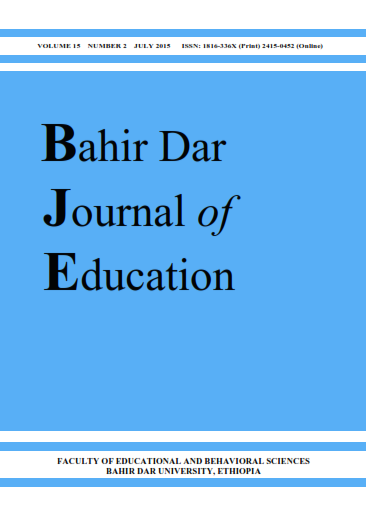The Ethiopian Higher Education Equity Policy and its Flaws
Abstract
This paper seeks to examine and understand the Ethiopian higher education equity policy issues. It is document-based research using different policy and research documents and reports as primary and secondary sources of data. The basis for the analysis is laid down through the review of a range of literature in the area of equity in general and equity in higher education in particular. The analysis of this study reveals that although there are some strong political and legal bases, as well as policy provisions, the issue of equity in higher education in Ethiopia is addressed in a fragmented and insufficient way. The equity policies are found to be inadequate in terms of the equity groups identified and the equity measures prescribed. Moreover, some of the equity measures suggested appear to be ambiguous and short-sighted. The paper finally suggests the need to re-conceptualize the issues of equity in Ethiopian higher education policies in order to lay a comprehensive foundation to recognize the equity groups adequately, as well as to identify appropriate and sufficient equity measures.References
Altbach, P. G., Reisberg, L., & Rumbley, L. (2010). Trends in global higher education : Tracking an academic revolution. Paris: UNESCO
Anderson, G. (2006). Assuring quality/resisting quality assurance: Academics’ responses to ‘quality’ in some Australian universities. Quality in Higher Education, 12(2), 161173.
Blakemore, K., & Griggs, E. (Eds.). (2007). Social policy: An introduction (3 ed.). Maidenhead: Open University Press.
Bloom, D., Canning, D., & Chan, K. (Eds.). (2005). Higher Education and Economic Development in Africa. Washington, DC.: World Bank.
Clancy, P., & Goastellec, G. (2007). Exploring access and equity in higher education: Policy and performance in comparative perspective. Higher Education Quarterly, 61(2), 136154.
EPRDF. (2005). Ethiopian Peoples Revolutionary Democratic Front (EPRDF) Statute.
FDRE. (1994). Education and Training Policy. Addis Ababa: St. George Printing Press.
FDRE. (1995). The Constitution of Federal Democratic Republic of Ethiopia (FDRE). Addis Ababa: FDRE.
FDRE. (2003). Higher Education Proclamation No. 351/2003. Addis Ababa: Negarit Gazeta.
FDRE. (2009). Higher Education Proclamation No. 650/2009. Addis Ababa: Negarit Gazeta.
Goastellec, G. L. (2010). Understanding inequalities in, through and by higher education. Rotterdam: Sense Publishers.
Hodkinson, A., & Deverokonda, C. (2009). Conceptions of inclusion and inclusive education: a critical examination of the perspectives and practices of teachers in India. International Journal of Research in Education, 85-99.
Martin, M. (Ed.). (2010). Equity and Quality assurance: Can they come together? An introduction to the problematic. (36 th ed.). Paris: UNESCO.
McCowan, T. (2007). Expansion without equity: An analysis of current policy on access to higher education in Brazil. Higher Education, 53(5), 579-598.
MoE. (2002). The education and training policy and its implementation. Addis Ababa: MoE.
MoE. (2005). Education Sector Development Programme III (ESDP-III) 2005/2006 – 2010/2011. Addis Ababa: MoE.
MoE. (2010). Education Sector Development Programme IV (ESDP IV) 2010/2011 – 2014/2015. Addis Ababa: MoE.
MoE. (2013) Educaion statistics annaul abstract 2005 E.C. (2012/2013). Addis Ababa. MoE
Negash, T. (1996). Rethinking education in Ethiopia. Uppsala: Nordiska Afrikainstitutet
Nussbaum, M. C. (2000). Women and human development: The capabilities approach. New York: Cambridge University Press.
OECD (Ed.). (2008). Tertiary education for the knowledge society, special features: equity, innovation, labour market internationalisation (Vol. 2). Paris: OECD.
Plous, S. (2003). Ten myths about affirmative action. In S. Plous (Ed.), Understanding prejudice and discrimination (pp. 206-212). New York: McGraw-Hill.
Saint, W. (2004). Higher education in Ethiopia: The vision and its challenges. Journal of Higher Education in Africa, 2(3), 83-113.
Schuller, T. (2003). Age equality in access to education. In S. Fredman & S. Spencer (Eds.), Age as an inequality issue. Oxford: Hart.
Sen, A. (1992). Inequality reexamined. New York: Russell Sage Foundation
Sen, A. (2009). The idea of justice. London: Allen Lane.
Sobrinho, J. D. (2008). Quality, pertinence, and the social responsibility of the Latin American and Caribbean University. In A. L. Gazzola & A. Didriksson (Eds.), Trends in higher education in Latin America and the Caribbean (pp. 83-108). Caracas: IESALC-UNESCO.
Teferra D., and Altbach, P.G. (2004) African higher education: Challenges for the 21 st century. Higher Education, 47(1), 21-50
.
Teshome, A. (2009). A review of education policy, strategies and programme. In T. Assefa (Ed.), Digest of Ethiopia’s National Policies, Strategies and Programme (pp. 46-92). Addis Ababa: Forum for Social Studies.
UNESCO. (1998). Higher education in the twenty-first century: Vision and action. Paris: Unesco.
UNESCO (Ed.). (2003). Overcoming exclusion through inclusive approaches in Education: A challenge and vision. Paris: UNESCO.
United Nations. General Assembly. (1948). Universal Declaration of Human Rights. Approved by the General Assembly at its Plenary Meeting on 6 December, 1948: pp. 6. [Lake Success,]
Wondemu, H. (2004). Gender and regional disparities in opportunities to higher education in Ethiopia: Challenges for promotion of social justice. The Ethiopian Journal of Higher Education, 1(2), 1-16.
World Bank. (2000). Higher education in developing countries: Peril and promise. Washington, D.C. : World Bank.
World Bank. (2003). Higher education development for Ethiopia: Pursuing the Vision. Washington, DC: World Bank, Human Development Department, Africa Region.
Yizengaw, T. A. (2007). The Ethiopian higher Education: Creating space for reform. Addis Ababa: [s.n.].
Authors who publish with this journal agree to the following terms:
- Authors retain copyright and grant the journal right of first publication with the work simultaneously licensed under a Creative Commons Attribution License that allows others to share the work with an acknowledgement of the work's authorship and initial publication in this journal.
- Authors are able to enter into separate, additional contractual arrangements for the non-exclusive distribution of the journal's published version of the work (e.g., post it to an institutional repository or publish it in a book), with an acknowledgement of its initial publication in this journal.
- Authors are permitted and encouraged to post their work online (e.g., in institutional repositories or on their website) prior to and during the submission process, as it can lead to productive exchanges, as well as earlier and greater citation of published work (See The Effect of Open Access).

